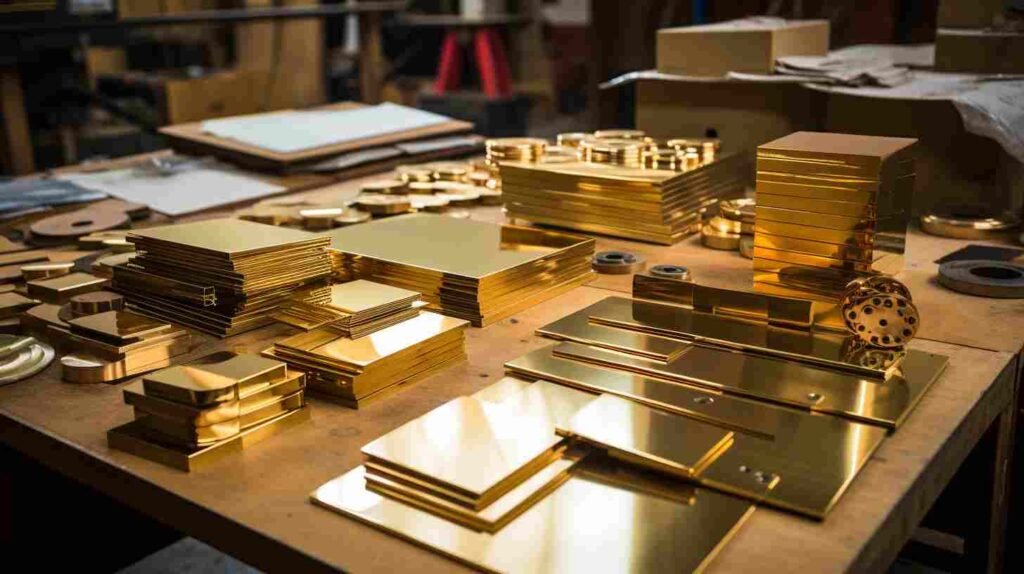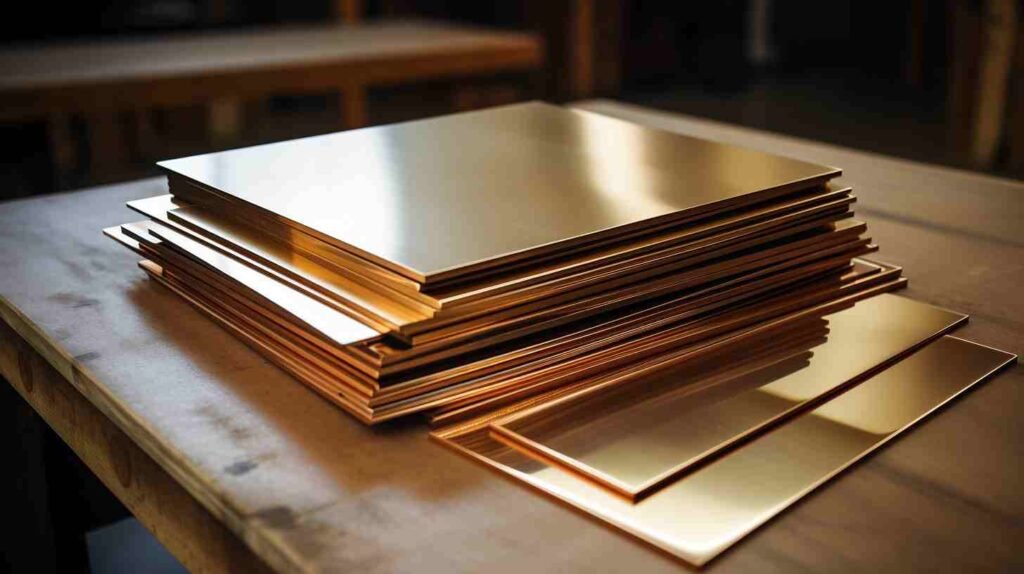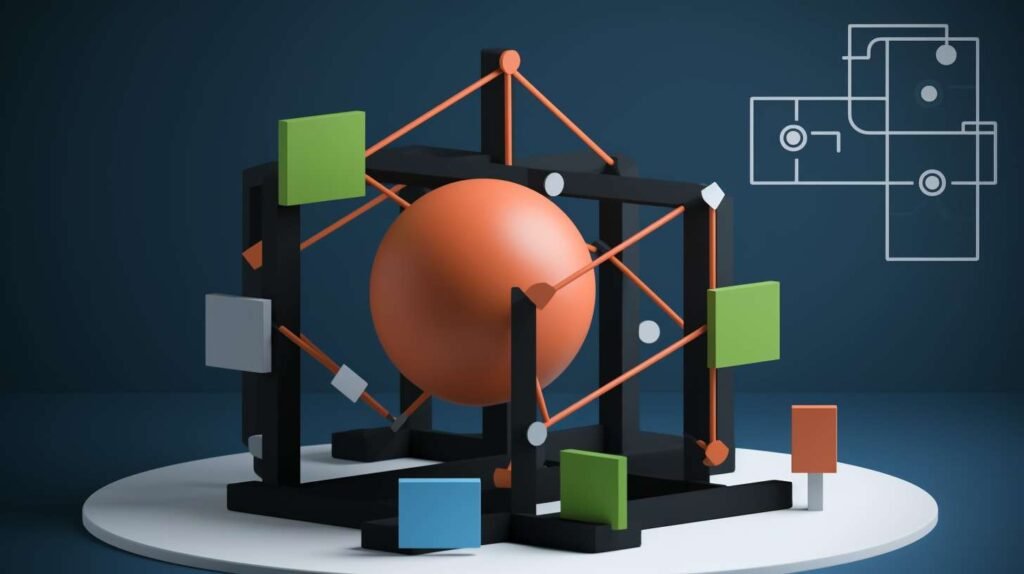Brass Sheet Metal Materials
Brass, a widely recognized copper-zinc alloy, showcases an impressive spectrum of variants, each distinguished by zinc proportions and potential alloying inclusions like aluminum, lead, or iron. Its foundational copper component renders it thermally and electrically conductive while ensuring commendable wear resistance. Beyond copper’s innate traits, brass excels in mechanical strength, reduced friction, and heightened corrosion resilience. Especially when it comes to sheet metal materials, the adaptability of brass is unparalleled. Opt for Brass Sheet Metal Materials for applications demanding a perfect blend of durability and aesthetic appeal, making it an unrivaled contender in sectors as demanding as the marine industry.

Brass At a Glance
| Application | Brass is used in a range of applications to include radiator cores, bearings, ammunition casings, and gears. |
|---|---|
| Advantages | Highly machinable, corrosion-resistant, low friction |
| Disadvantages | Tends to oxidize or tarnish if not maintained |
| Lead Time | Lead time is generally a minimum of 3 days. However, this can increase depending on the brass grade used or if the parts are to be internationally manufactured. |
| Tolerances | Machining tolerances depend on the brass used. However, a tolerance of 0.005 in (0.13mm) is generally achievable. |
| Wall Thickness | A minimum wall thickness of 0.03 in (0.8mm) is achievable. This can vary depending on the ratio of wall thickness to planar dimension. The specific brass grade used will also affect the achievable minimum wall thickness. |
| Max Part Size | The maximum size of the part is determined by the machines available and the complexity of the part. |
Cartridge Brass (Copper C260)
A unique blend that boasts approximately 30% zinc, Copper C260, also known as Cartridge Brass, stands distinguished with its trace elements of less than 1% lead and iron. This particular composition gives it its iconic name, stemming from its storied past in crafting ammunition cartridges. But its applications don’t stop at munitions; Cartridge Brass has proven indispensable in fabricating rivets, hinges, and even the core of radiators. Embracing history and functionality, Copper C260 is not just an alloy but a testament to the versatile legacy of metallurgy.
Cartridge Brass Properties
Tensile Strength, Yield (MPa)
75
Fatigue Strength (MPa)
90
Elongation at Break (%)
68
Hardness (Brinell)
53
Density (g/cm^3)
8.53
Free-Cutting Brass (Copper C360)
Free-Cutting Brass, also known as Copper C360, is an alloy distinctively marked by its lead content, usually around 3%. This unique composition grants it the title of ‘free-cutting’ due to its superior machinability attributes. Historically, this grade has been a favorite among artisans and craftsmen for intricate works, primarily because of its seamless carving capabilities. Today, its prevalent applications encompass gears, pinions, complicated instrument components, and ornamental hardware, a testament to its versatile and precision-friendly nature.
Free-Cutting Brass Properties
Tensile Strength, Yield (MPa)
124 to 310
Fatigue Strength (MPa)
138
Elongation at Break (%)
53
Hardness (Brinell)
63 to 130
Density (g/cm^3)
8.49
Finishes
Brass, with its golden allure, is a popular choice in manufacturing. Its natural resilience against corrosion, impressive conductivity, and minimal friction make it often used in its raw form. Yet, when the intention leans towards visual appeal or the component confronts external elements, a transparent protective layer becomes a consideration. Delve into some of the top finishes for sheet metal brass:
Ornamental Brilliance: The diverse hues of various brass alloys lend themselves to decorative uses. A hand-polished brass component radiates with a gleaming sheen, perfect for design-centric applications.
Untouched Excellence: The innate beauty of freshly machined brass often requires no enhancement. When perfected with extra finishing strokes, the’ As Machined’ finish achieves a smooth and attractive look, making further embellishments optional.


Cost-saving Design Tips
Optimal Material Selection: Not all metals created for sheet metal fabrication are equally cost-effective and efficient. Prioritize understanding the specific requirements of your project. While some metals excel in certain conditions, they may falter in others. A comprehensive understanding of their reactions in diverse environments can be crucial. Consult with a Fabrication Pro for insights.
Adherence to DFM: Embracing the DFM (design-for-manufacturing) ethos is pivotal when sketching out designs for sheet metal parts. Familiarize yourself with essential design principles to harness the full potential of fabrication methods without inflating costs.
Get A Free Quote
Contact us to get a free quote and more expertise about sheet metal fabrication. Your project will meet the right solution with Shengen.
Custom Sheet Metal Fabrication with Easy
At Shengen, We turn complex Into Simple! Follow the following three steps to start today!
- Tell us as specific as possible of your needs, provide the drawing, reference picture and share your idea.
- We will work on the best solution according to your requirements and drawing, the specific quote will be provided within 24 hours.
- We will start mass production after getting your approval and deposit, and we will handle the shipment.
